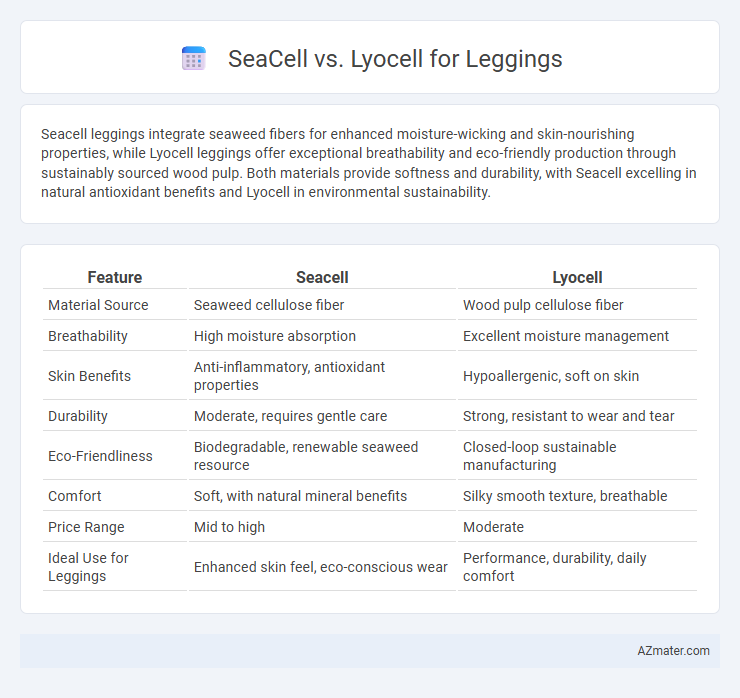Seacell leggings integrate seaweed fibers for enhanced moisture-wicking and skin-nourishing properties, while Lyocell leggings offer exceptional breathability and eco-friendly production through sustainably sourced wood pulp. Both materials provide softness and durability, with Seacell excelling in natural antioxidant benefits and Lyocell in environmental sustainability.
Table of Comparison
| Feature | Seacell | Lyocell |
|---|---|---|
| Material Source | Seaweed cellulose fiber | Wood pulp cellulose fiber |
| Breathability | High moisture absorption | Excellent moisture management |
| Skin Benefits | Anti-inflammatory, antioxidant properties | Hypoallergenic, soft on skin |
| Durability | Moderate, requires gentle care | Strong, resistant to wear and tear |
| Eco-Friendliness | Biodegradable, renewable seaweed resource | Closed-loop sustainable manufacturing |
| Comfort | Soft, with natural mineral benefits | Silky smooth texture, breathable |
| Price Range | Mid to high | Moderate |
| Ideal Use for Leggings | Enhanced skin feel, eco-conscious wear | Performance, durability, daily comfort |
Introduction to Seacell and Lyocell Fibers
Seacell fibers are derived from a blend of cellulose from wood pulp and seaweed, known for their skin-soothing properties and natural bioactive ingredients, making them ideal for sensitive skin in leggings. Lyocell fibers are produced from sustainably sourced wood pulp through a closed-loop process, offering high moisture absorption, breathability, and a smooth, soft texture that enhances comfort during wear. Both fibers provide eco-friendly alternatives with unique benefits, where Seacell emphasizes skin health and Lyocell focuses on durability and moisture management in legging fabrics.
What is Seacell? Material Overview
Seacell is an innovative fabric combining cellulose fibers with natural seaweed, offering unique skin-nourishing properties and sustainable benefits. Unlike Lyocell, a regenerated cellulose fiber derived from wood pulp, Seacell incorporates bioactive compounds from seaweed that promote moisture retention and provide antioxidant effects in leggings. This fusion of natural fibers makes Seacell leggings highly breathable, eco-friendly, and ideal for sensitive skin while supporting marine resource sustainability.
Understanding Lyocell: Features and Composition
Lyocell is a sustainable fiber derived from sustainably sourced wood pulp, primarily eucalyptus, processed using a closed-loop system that recycles water and solvents, minimizing environmental impact. Its smooth, cellulose-based composition offers superior moisture-wicking, breathability, and softness, making it ideal for leggings that require comfort and durability. Compared to SeaCell, which incorporates seaweed extract for skin benefits, Lyocell stands out for its eco-friendly production and exceptional fabric strength.
Sustainability Comparison: Seacell vs Lyocell
Seacell leggings incorporate seaweed fibers that offer biodegradability and natural skin benefits, supporting marine ecosystem sustainability. Lyocell leggings use wood pulp processed with a closed-loop system that recycles water and solvents, resulting in low environmental impact and reduced chemical waste. Both fibers provide eco-friendly alternatives to conventional fabrics, but Lyocell's industrial-scale closed-loop production emphasizes resource efficiency, while Seacell uniquely contributes marine-derived nutrients to textile sustainability.
Comfort and Feel: Which Fiber is Softer for Leggings?
Seacell fibers offer superior softness in leggings due to their blend of cellulose and seaweed, which provides a smooth, silky texture against the skin. Lyocell, made from sustainably sourced wood pulp, delivers a soft and breathable fabric but typically feels firmer compared to the naturally moisturizing, gentle touch of Seacell. For maximum comfort and a luxurious feel, Seacell leggings are often preferred over Lyocell for their enhanced softness and skin-friendly properties.
Moisture-Wicking Abilities: Seacell vs Lyocell
Seacell and Lyocell both excel in moisture-wicking properties, but Lyocell outperforms due to its smooth fiber structure that quickly absorbs and releases moisture, keeping leggings dry and comfortable during intense workouts. Seacell, infused with seaweed extracts, offers natural antimicrobial benefits that reduce odor while providing moderate moisture management. For leggings demanding superior breathability and moisture control, Lyocell remains the preferred choice.
Breathability and Temperature Regulation
Seacell leggings feature natural seaweed fibers that enhance breathability and promote moisture-wicking, helping maintain a cool and dry feel during wear. Lyocell leggings, made from sustainably sourced wood pulp, excel at temperature regulation by absorbing and releasing moisture efficiently, offering a balance of warmth and cooling properties. Both materials provide superior comfort, but Seacell prioritizes moisture management with a cooling effect, while Lyocell focuses on adaptive temperature control for varied climates.
Durability and Longevity of Seacell and Lyocell Leggings
Seacell leggings offer excellent durability due to their cellulose fibers infused with seaweed, enhancing fabric strength and resistance to wear. Lyocell leggings, made from sustainably sourced eucalyptus fibers, are known for their high tensile strength and resistance to pilling, providing long-lasting comfort. Both materials provide superior longevity, but Seacell's added bioactive components contribute to maintaining fabric integrity over extended use.
Skin Benefits: Hypoallergenic Properties Explored
Seacell and Lyocell leggings both offer hypoallergenic benefits ideal for sensitive skin, with Seacell containing natural seaweed fibers that provide antioxidant and anti-inflammatory properties. Lyocell is made from eucalyptus wood pulp, known for its breathable, moisture-wicking qualities that reduce skin irritation and prevent bacterial growth. Consumers seeking leggings with enhanced skin-soothing effects often prefer Seacell for its bioactive compounds, while Lyocell is favored for superior softness and sustainable moisture management.
Seacell vs Lyocell: Which is Best for Eco-Friendly Leggings?
Seacell and Lyocell both offer sustainable options for eco-friendly leggings, but Seacell stands out with its infusion of seaweed fibers, providing natural antibacterial and skin-soothing properties. Lyocell is known for its exceptional moisture-wicking capabilities and biodegradability, derived from sustainably sourced eucalyptus wood, making it an excellent choice for comfort and environmental impact. Choosing between Seacell and Lyocell depends on prioritizing either natural bioactive benefits or superior moisture management in sustainable activewear.

Infographic: Seacell vs Lyocell for Legging
 azmater.com
azmater.com